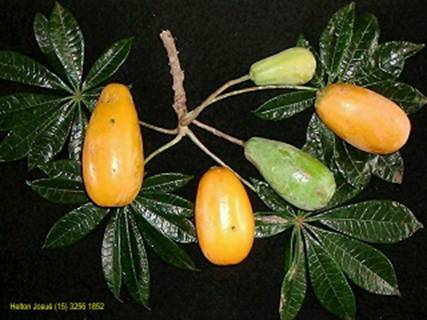JARACATIA SPINOSA
NOME POPULAR: Jaracatiá, Mamão de espinho.
Caricaceae

NAME: Jaracatiá, comes from the Tupi and means "fruit of the tree of stalk or soft trunk."
Origin: Altitude forests of the Atlantic Forest and the gallery of savannas from Minas Gerais to Rio Grande do Sul, Argentina, Paraguay and the Andes.
Characteristics:
The tree grows up
to
Planted in the site of Frutas Raras: August 2001 and further 2 trees in October 2002, bloomed for the first time in 2005, didn't bear fruit yet.
Tips for
cultivation:
Quickly growing
plant,
appreciates
deep soils which are
rich of organic matter, resistant to low temperatures to -1°C (30°F),
thrives from sea level up to altitudes of
Propagation: The
seeds are small and germinate in
Planting:
6 x 6 m of space between
trees, grows well in full sun and in shaded woods.
The holes must contain 40% organic matter and neutral pH, achieved with
the incorporation of
Cultivating: The
plant requires no pruning.
The fertilization with organic compost is sufficient, can be (
Uses: The pulp is yellowish orange, resembling the flavor of passion fruit and mango, contain latex that burns the tongue and the lips of some sensitive people, so enjoy the fruits should be mature and can be eaten shell and all, but eating small amounts because of the laxative effect. Can also be used to make juices and sweets. The trunk is used to make a sweet similar to cocada.
Flowering in the site of Frutas Raras: October to December.
Fruiting in the site of Frutas Raras: February to March.
BUY THE BOOK “COLECIONANDO FRUTAS”
Back to the seedlist (English) or back to Caricaceae (Portuguese)